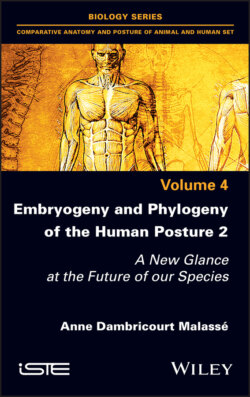Читать книгу Embryogeny and Phylogeny of the Human Posture 2 - Anne Dambricourt Malasse - Страница 15
1.2.4. The Institut de Paléontologie Humaine, a foundation of Prince Albert 1st of Monaco
ОглавлениеThe Institut de Paléontologie Humaine (Institute of Human Paleontology) was created on July 23, 1910 with the personal funds of Prince Albert 1st of Monaco. The foundation owed much to exchanges with Henri Breuil. Completed in 1914, the building is a veritable palace built over five levels with a floor area of 1,200 m2. The three facades are decorated with friezes that catch the eye of the passer-by, illustrating different cultures, from different latitudes, Inuit, native Americans, central Africans, converging toward the monumental entrance door, which takes up the style of glass and wrought iron of the great gallery of paleontology.
The skull of the La Chapelle-aux-Saints Man is enthroned above the porch, while on either side, an artist has carved a profile of a buffalo or sculpted the body of a naked woman in the rock (the Venus of Laussel, in the Dordogne, dating to the Gravettian period). The skull of the Cro-Magnon Man is on the left, that of La Chapelle-aux-Saints on the right, associated with prehistoric ornaments. Part of the coat of arms of the Principality of Monaco overlooks the monumental entrance, but the two monks and the motto “Deo Juvante” (“with God’s help”) have been removed to mark the secular spirit of the place. By climbing the steps to the porch, the visitor understands that here, Man is studied not only in his animality, but also with what makes him a singular being in the evolution of the animal kingdom, through the expression of a symbolic thought that is revealed through the creative act of the artistic gesture.
The architecture is organized around a conference and exhibition room under a huge glass dome, whose height occupies the first three levels, a large library, three rooms for the collections corresponding to the three teaching chairs: human paleontology, fauna and prehistoric ethnology, plus photography and chemistry laboratories, as well as a drawing room and work offices. Marcellin Boule was the director-administrator, Henri Breuil held the chair of prehistoric ethnology, René Verneau held the chair of prehistoric anthropology and Hugo Obermaier (1877–1946) held the chair of geology applied to prehistory. The First World War postponed the inauguration of the foundation by the President of the Republic until December 23, 1920, in the presence of Prince Albert 1st:
It is to help anthropology overcome the barriers that separate it from the complete truth that I founded the Institute of Human Paleontology, giving it all the necessary independence to lead our spirit towards the light. And I entrust its interests to men who serve Science with a sincerity capable of developing its strength and protecting its march against the influence of passionate interventions. (ibid., author’s translation)
Marcellin Boule was now the director of the Paleontology Laboratory of the Muséum and the Institut de Paléontologie Humaine (IPH). He was at the head of the largest scientific organization covering the study of the evolution of fossil species, with collections, laboratories and teaching chairs. The paleoanthropological collections were rapidly enriched from 1909 to 1921, following the exceptional discovery of Neanderthal burials in the Ferrassie Cave in the Dordogne (southwestern France), containing two adults, three children, a newborn and two fetuses. The IPH thus became the first research center in the world entirely dedicated to the study and understanding of the origins of the human being.
Boule published his imposing monograph on the skeleton of La Chapelle-aux-Saints between 1911 and 1913 (Boule 1911–1913). At the same time, Henri Breuil transmitted the evolutionary doctrine of the chair of paleontology in his courses at the Institute:
In order to see all these forms come out of a single origin, we have to suppose three things: humanity began in a single region, probably towards the East, the human body was able to transform, the first men dispersed, living in physical and moral conditions that profoundly modified their organisms. (Breuil, in Hurel (2011), author’s translation)
